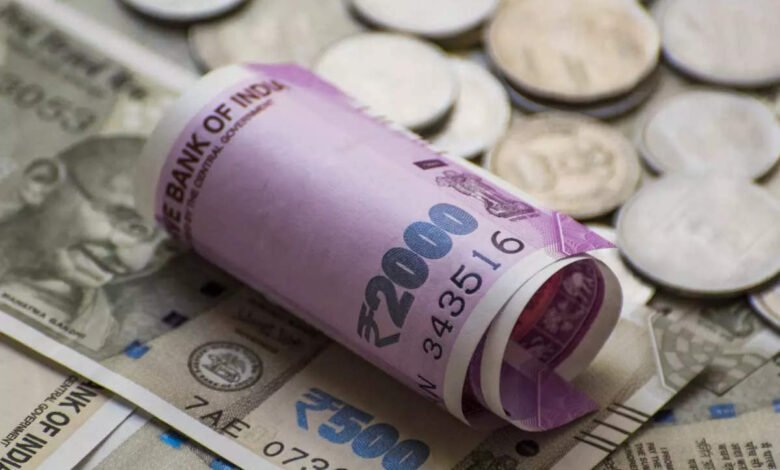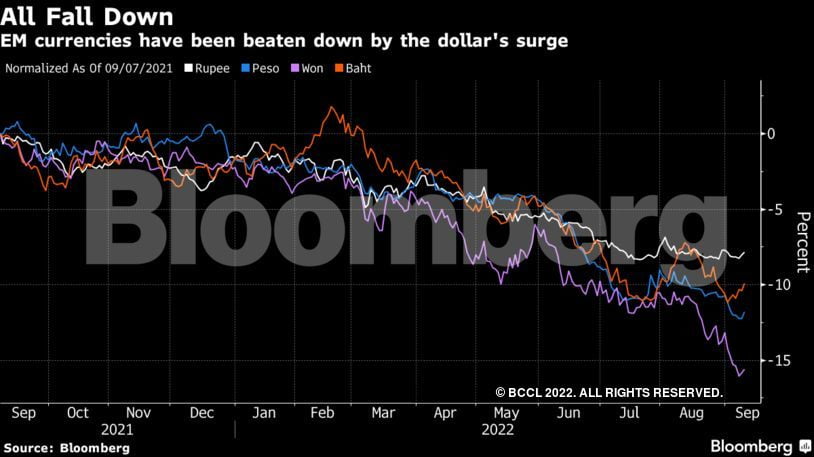Dwindling reserves may expose vulnerable Asian currencies

Emerging Asian central banks have recently witnessed a steep decline in their foreign exchange reserves, lending to concerns over disruption of market interventions to curb currency losses against the dollar.
A closely watched measure of reserves cover the number of months of imports a country can finance with its foreign-exchange holdings, which has dropped to about seven for EM Asia ex-China, the lowest since the global financial crisis in 2008, according to Standard Chartered PLC. It was about 10 months at the beginning of the year and as high as 16 in August 2020, pointing to an erosion of developing nation firepower to defend currencies.
“The deterioration indicates that central bank intervention to support local currencies might be much more limited going forward. Overall, we expect central banks’ FX policy to turn less supportive.”” Divya Devesh, head of Asean and South Asia FX research at Standard Chartered in Singapore said last week.
According to data compiled by Bloomberg, Thailand saw the biggest drop in reserves as a percentage of the gross domestic product, followed by Malaysia and India. Reserves cover about nine months of imports for India, six for Indonesia, around eight for Philippines and seven for South Korea, Standard Chartered said.
Central banks across Asia have relied on reserves to protect their currencies against a resurgent dollar as aggressive Federal Reserve policy tightening spurred flows back to the US.
Any indication of a slowdown in market interventions may exacerbate losses for Asian currencies, many of which hit record or multi-year lows recently.

Emerging Asian central banks have recently witnessed a steep decline in their foreign exchange reserves, lending to concerns over disruption of market interventions to curb currency losses against the dollar.
A closely watched measure of reserves cover the number of months of imports a country can finance with its foreign-exchange holdings, which has dropped to about seven for EM Asia ex-China, the lowest since the global financial crisis in 2008, according to Standard Chartered PLC. It was about 10 months at the beginning of the year and as high as 16 in August 2020, pointing to an erosion of developing nation firepower to defend currencies.
“The deterioration indicates that central bank intervention to support local currencies might be much more limited going forward. Overall, we expect central banks’ FX policy to turn less supportive.”” Divya Devesh, head of Asean and South Asia FX research at Standard Chartered in Singapore said last week.
According to data compiled by Bloomberg, Thailand saw the biggest drop in reserves as a percentage of the gross domestic product, followed by Malaysia and India. Reserves cover about nine months of imports for India, six for Indonesia, around eight for Philippines and seven for South Korea, Standard Chartered said.
Central banks across Asia have relied on reserves to protect their currencies against a resurgent dollar as aggressive Federal Reserve policy tightening spurred flows back to the US.
Any indication of a slowdown in market interventions may exacerbate losses for Asian currencies, many of which hit record or multi-year lows recently.
Emerging Asian central banks have recently witnessed a steep decline in their foreign exchange reserves, lending to concerns over disruption of market interventions to curb currency losses against the dollar.
A closely watched measure of reserves cover the number of months of imports a country can finance with its foreign-exchange holdings, which has dropped to about seven for EM Asia ex-China, the lowest since the global financial crisis in 2008, according to Standard Chartered PLC. It was about 10 months at the beginning of the year and as high as 16 in August 2020, pointing to an erosion of developing nation firepower to defend currencies.
“The deterioration indicates that central bank intervention to support local currencies might be much more limited going forward. Overall, we expect central banks’ FX policy to turn less supportive.”” Divya Devesh, head of Asean and South Asia FX research at Standard Chartered in Singapore said last week.
According to data compiled by Bloomberg, Thailand saw the biggest drop in reserves as a percentage of the gross domestic product, followed by Malaysia and India. Reserves cover about nine months of imports for India, six for Indonesia, around eight for Philippines and seven for South Korea, Standard Chartered said.
Central banks across Asia have relied on reserves to protect their currencies against a resurgent dollar as aggressive Federal Reserve policy tightening spurred flows back to the US.
Any indication of a slowdown in market interventions may exacerbate losses for Asian currencies, many of which hit record or multi-year lows recently.
Emerging Asian central banks have recently witnessed a steep decline in their foreign exchange reserves, lending to concerns over disruption of market interventions to curb currency losses against the dollar.
A closely watched measure of reserves cover the number of months of imports a country can finance with its foreign-exchange holdings, which has dropped to about seven for EM Asia ex-China, the lowest since the global financial crisis in 2008, according to Standard Chartered PLC. It was about 10 months at the beginning of the year and as high as 16 in August 2020, pointing to an erosion of developing nation firepower to defend currencies.
“The deterioration indicates that central bank intervention to support local currencies might be much more limited going forward. Overall, we expect central banks’ FX policy to turn less supportive.”” Divya Devesh, head of Asean and South Asia FX research at Standard Chartered in Singapore said last week.
According to data compiled by Bloomberg, Thailand saw the biggest drop in reserves as a percentage of the gross domestic product, followed by Malaysia and India. Reserves cover about nine months of imports for India, six for Indonesia, around eight for Philippines and seven for South Korea, Standard Chartered said.
Central banks across Asia have relied on reserves to protect their currencies against a resurgent dollar as aggressive Federal Reserve policy tightening spurred flows back to the US.
Any indication of a slowdown in market interventions may exacerbate losses for Asian currencies, many of which hit record or multi-year lows recently.




